
About UsThe Numismatic Bibliomania Society is a non-profit organization promoting numismatic literature. For more information please see our web site at coinbooks.org SubscriptionsThose wishing to become new E-Sylum subscribers (or wishing to Unsubscribe) can go to the following web page link MembershipThere is a membership application available on the web site Membership Application To join, print the application and return it with your check to the address printed on the application. Membership is only $15 to addresses in the U.S., $20 for First Class mail, and $25 elsewhere. For those without web access, write to: David M. Sundman, Secretary/TreasurerNumismatic Bibliomania
Society AsylumFor Asylum mailing address changes and other membership questions, contact David at this email address: dsundman@LittletonCoin.com SubmissionsTo submit items for publication in The E-Sylum, just Reply to this message, or write to the Editor at this address: whomren@coinlibrary.com
BUY THE BOOK BEFORE THE COINYou won't regret it! |
- WAYNE'S WORDS: THE E-SYLUM JANUARY 17, 2010
- LAKE BOOKS 101ST NUMISMATIC LITERATURE SALE CLOSES JANUARY 19, 2010
- KOLBE 111TH SALE RESULTS: STACK FAMILY LIBRARY & ANS DUPLICATES
- 2010 NEW YORK INTERNATIONAL SHOW REPORT
- WHITMAN PUBLISHING 2009 REVIEW AND 2010 OUTLOOK
- JAMES MEASE, GEORGE WASHINGTON AND ANTHONY WAYNE'S STONEY POINT MEDAL
- COIN WORLD'S 50TH ANNIVERSARY CELEBRATION PLANS
- THE 1974 ASSAY COMMISSION AND THE ALUMINUM CENTS
- VOCABULARY ANSWER: A MEDAL WITH PORTRAIT BUT NO NAME
- MORE ON CIA MEDALS
- QUIZ ANSWER: WHAT ARE THESE COINS?
- QUERY: MEDAL MAKERS NOBLE & BENTON
- ARTICLE DOCUMENTS SOURCE OF A 1795 DOLLAR
- ROGER DEWARDT LANE'S REPORT ON THE 2010 FUN SHOW
- WAYNE'S NUMISMATIC DIARY: JANUARY 12, 2010
- MAN WITH "IMPOSSIBLE" DISPLAY OF MEDALS ADMITS DECEPTION
- MAN ARRESTED AFTER LEAVING $500 TIP
- FEATURED WEB PAGE: WASHINGTON BEFORE BOSTON MEDAL
WAYNE'S WORDS: THE E-SYLUM JANUARY 17, 2010

Among our new subscribers this week are Bob Stark, courtesy of Dave Perkins, Sam Savino, and Millard F. Mann. Welcome aboard! We now have 1,308 subscribers.
Joe Boling writes:
You misspelled Scott Semans' name again last week, and Werner Talso is actually Warner Talso.
Sorry - the mistakes were all mine.
This week we open with a note from Fred lake and a report on the Stack Family Numismatic Library auction from George Kolbe. Next up are a report on the New York International from John Adams, and a look at 2009 and 2010 from Whitman Publishing's Dennis Tucker.
Other topics this week include COIN World's 50th anniversary celebration plans, the 1974 Assay Commission, James Mease, CIA medals, and medal makers Noble & Benton.
To learn about "free 'taters for out-of-staters" and the letter to Wayne from George Washington, read on.
Wayne Homren
Numismatic Bibliomania Society
LAKE BOOKS 101ST NUMISMATIC LITERATURE SALE CLOSES JANUARY 19, 2010
This is a reminder that our 101st mail-bid sale of numismatic literature will close on Tuesday, January 19, 2010 at 5:00 PM (EST). The sale features selections from the library of Fred Iskra and has reference material from all facets of the numismatic experience. You can view the catalog at http://www.lakebooks.com/current.html
Bids may be entered via email, fax, or telephone until the closing time. Good Luck with your bidding !
For more information, see: www.lakebooks.com
KOLBE 111TH SALE RESULTS: STACK FAMILY LIBRARY & ANS DUPLICATES
For only the second time, a single-day numismatic literature auction sale has grossed over a million dollars. On June 1, 2004, the first one thousand lots of the John J. Ford, Jr. library brought 1.66 million dollars, eclipsing the four Armand Champa library sales (just under 1 million dollars), and the five Harry Bass library sales (1.25 million dollars).
And on January 9th, 2010, George Frederick Kolbe/Fine Numismatic Books sold at public auction 400 highlights from the Stack Family numismatic and 100 duplicates from the American Numismatic Society Library. Estimates for the 500 lots came to $540,000 and the total hammer price was $873,000, exceeding the estimates by over 60%. Including the 15% buyer premium, the sale realized slightly over a million dollars. Every lot found a buyer and the per lot average of $2,000 is the highest ever achieved.
Sixty-eight registered bidders jammed the saleroom and, along with a dozen telephone bidders and over thirty internet bidders, purchased over 90% of the lots in the sale, overwhelming unusually strong participation by absentee bidders.
Those interested in learning more about this landmark sale or in accessing the catalogue and prices realized list online may do so by visiting: www.numislit.com. A limited number of well illustrated catalogues, including a prices realized list, may still be ordered by sending $35.00 to George Frederick Kolbe, Fine Numismatic Books, P. O. Drawer 3100, Crestline, CA 92325.
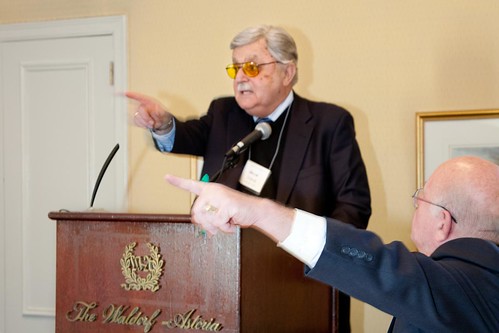
The first 190 lots in the sale were comprised of works on American numismatics from the Stack Family library. As he came to the podium to call the first few lots in the sale, Harvey Stack, who joined the family firm in 1947, received a hearty round of applause. Harvey returned to the podium a little later, to auction lots 79 and 80.
Lot 80 was Joseph Stack's three volume photographic record of the fabled collection of $2.50, $5.00, and $10.00 United States gold coins from the collection of Colonel E. H. R. Green; it and lot 79, original inventory records and other materials relating to the acquisition by Stacks of Colonel Green's gold coins, shared top honors, each realizing $80,500 [all results reported include the 15% buyer premium].
The family's complete bound set of Stack's auction sale catalogues brought $63,250 and their complete bound set of Coin Galleries publications, estimated at $5000, brought $29,900. Henry Chapman's 1883 Andrews work on large cents realized $3,220 on a $300 estimate and the 1911 Henry Chapman Siedlecki sale with plates sold for $5,750 on a $3000 estimate.
Several classic works on large cents from the library of Henry Hines, often filled with letters and research notes, all brought prices well over their estimates, as did two inventories of the Louis Eliasberg collection.
The 1915 United States Coin Co. sale of the Granberg collection with plates was estimated at $4,000 and realized $5,750. The first six volumes of The Numismatist brought $20,700 and the American Journal of Numismatics sold for $14,950. J. N. T. Levick's own annotated copy of his April 27-29, 1865 coin collection (postponed to May 28, 1865 due to the assassination of President Lincoln), sold for $12,650 and a large paper copy of Hickcox's 1858 "Historical Account of American Coinage" realized $19,950.
Classic works on ancient and foreign numismatic topics generally brought strong prices, including a complete original set of Georgii Mikhailovic's monumental work on Russian coins, bound in thirteen volumes, @ $51,750. Classic Russian coin sales all brought well over estimate and an original Haeberlin on Aes Grave realized $4,887. Gnecchi's great three volume work on Roman medallions brought $3,737 and a complete run Ars Classica ancient coin sales sold well. Classic sets on medieval and modern German numismatics included Bahrfeldt on Marienburg @ $4,255 and Fiala on Brunswick @ $1,840.
Highlights among the sale of 100 duplicate numismatic works from The American Numismatic Society included classic European auction sale catalogues featuring ancient coins, among them Rhousopoulos, Montagu and Ponton d'Amécourt on Roman gold coins, Bunbury, Lockett, Ratto Byzantine, and others. Nearly all sold for well over estimate. Browning's original 1925 Early Quarter Dollars of the United States sold for $2,760 and Nützel's 1898-1902 Katalog der Orientalische Münzen realized $$4,600 on a $1,250 estimate. Miles' Numismatic History of Rayy sold for a reasonable $690, while a nine volume set of Sestini's Lettere e Dissertazioni Numismatiche from the Newell library realized $3,450 on a $1,500 estimate. The rare 1925 W. W. C. Wilson sale of American and Canadian coins and medals, with photographic plates, sold for $3,737 on a $2,500 estimate.
George adds:
We have been receiving many last-minute requests for bound copies of the Stack Family Library sale catalogue and have decided to extend the ordering deadline to Wednesday January 20th. The price is $95.00 postpaid for copies sent in the U. S. (the ANS Duplicate sale catalogue will also be bound in).

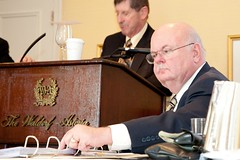
A second Stack Family Library sale is planned for June 2010. Catalogues may be reserved by sending $10 to Kolbe at P. O. Box 3100, Crestline, CA 92325-3100.
2010 NEW YORK INTERNATIONAL SHOW REPORT

Seeing Alan Weinberg's notes on the FUN Convention prompted me to write to you about the New York International. This show focuses on classical coinage, medals and the European series. It brings together the leading dealers from Europe and the U.S. who, because of the high cost of the show, can be relied upon to bring excellent offerings for the bourse.
There are half a dozen auctions associated with the show, the only one of which that we attended being George Kolbe's sale of the Stack Family Library. Here, complete runs of the AJN and The Numismatist went for less than estimate whereas almost every thing else went above. Desirable items, such as Clapp on 1798-1799, Newcomb 0n !801-02-03 and Gilbert on 1796 were made even more desirable by the inclusion of relevant correspondence from the large cents great and, in the case of the Gilbert, a set of the Brobston plates (of which only three are known). A truly memorable sale made all the more so by the presence of Harvey and Larry Stack.
Back to the show, included therein was the annual ANS Gala, this year honoring Victor England, a highly respected dealer in classical coinage. Despite a ticket price of $500 per head, more than 200 individuals attended, including many of the great names in our hobby. Despite the pricey entrance fee, the food, wine, dancing, special auctions and good company are well worth it.
The bourse is a folksy affair, spread out into a number of smaller rooms as well as the one large one. Hearing many languages spoken enhances the atmosphere of a bazaar as compared to a meat market. Not to brag but to illustrate the menu, Regina and I acquired a multithaler, an electro of a multithaler, a Betts medal, a Comitia Americana trial piece, two Admiral Vernon's, a terracotta portrait by Reynaud and two cat medals.
Fortunately, we don't collect ancients. (We did view one to be auctioned: a sixth century gold medallion given by the Emperor Tiberius II to his daughter on the occasion of her marriage. The medallion came complete with an intricate border attached, a heavy hangar (both of these in gold) and an estimate of $2,500,000 !
Also part of the International are a number of club meetings. We attended one for Medal Collectors of America where we were treated to an outstanding talk by Ben Weiss on medals depicting intolerance. There were over forty in attendance, which would be an above average crowd for the Numismatic Theatre in August.
All in all, the show has much to offer which can be found nowhere else.
WHITMAN PUBLISHING 2009 REVIEW AND 2010 OUTLOOK
At first glance it might seem like Whitman's numismatic titles have slowed down lately --- but pound for pound I think we're keeping up with recent years! Some of our 2009 books were mammoth productions: Dave Bowers's Whitman Encyclopedia of U.S. Paper Money and the Whitman Encyclopedia of Colonial and Early American Coins come to mind. Fred Reed's Abraham Lincoln: The Image of His Greatness was also a major undertaking; lots of "moving parts" in that one. The Professional Edition of the Red Book was, as you can imagine, a huge project.
Our editorial and art departments always have books in various stages of development. Some of them are massive and keep us busy for months or years, all behind the scenes until we're ready to fire up the publicity. We've got some exciting new works along those lines, to be unveiled in 2011 and beyond. I can't go into specifics at the moment, but I can confirm that they touch on most fields of the hobby: world coins, ancient coins, paper money (old and new), U.S. federal coinage, errors and varieties, numismatic history, etc.
2009 was a banner year for non-numismatic Whitman titles, as well. In some ways we've started to recapture the flavor of the "old days" of Racine, when Whitman and Western Publishing dished out a smorgasbord of themes and genres. We came out with three different Barack Obama "Vault" books, two titles on Michael Jackson, a Vault on Elvis Presley, another on vampires, and dozens more on various sports topics.
Closer to the Antiques/Collectibles arena was Kenneth Rendell's World War II: Saving the Reality, which has been reviewed in the New York Times, PARADE Magazine, Town & Country, and other national media. Some E-Sylum readers will recognize Rendell as a founding member (along with Q. David Bowers, Eric Newman, Ken Bressett, and others) of the Rittenhouse Society, and as the autograph expert who famously debunked the so-called Hitler Diaries.
We rolled out electronic versions of the Whitman Encyclopedia of U.S. Paper Money and the Professional Edition Red Book. Both of these books are available in searchable high-res DVD.
 Looking to 2010: we've got some neat books coming out this year, including two for the National Park quarters series. I predict that coinage program will be another boon for the hobby, similar to the State quarters, as well as for the parks system. Bob Leonard's Curious Currency (a beautifully illustrated and engagingly written book) will be out in a few weeks. We've got an interactive book on buying and selling gold, by Jeff Garrett and Dave Bowers, in the works.
Looking to 2010: we've got some neat books coming out this year, including two for the National Park quarters series. I predict that coinage program will be another boon for the hobby, similar to the State quarters, as well as for the parks system. Bob Leonard's Curious Currency (a beautifully illustrated and engagingly written book) will be out in a few weeks. We've got an interactive book on buying and selling gold, by Jeff Garrett and Dave Bowers, in the works.
NBS members Joel Orosz and Len Augsburger --- two of the best researchers and most entertaining writers in the hobby, in my opinion --- are finishing up their manuscript on Frank Stewart and the first Philadelphia Mint. To say that their work is groundbreaking is an understatement.
Other famous names who will take the Whitman stage in 2010 include Federal Reserve Note specialist Robert Azpiazu; Franklin half guru Rick Tomaska; Jim Halperin and Hector Cantu, who have coauthored a beautiful book on vintage collectible movie posters; the error-coin dream team of Nick Brown, David Camire, and Fred Weinberg; and a few others who will be announced anon.
We'll have updated editions in our popular Bowers Series, and, venturing abroad, a Japanese-language edition of the R.S. Yeoman / Arthur Friedberg classic, A Catalog of Modern World Coins! The Cherrypickers' Guide will be updated and expanded for die-variety enthusiasts, with some exciting news to announce in that field. And of course the Red Book and Blue Book are both under way, with the 2nd edition of the Professional Edition Red Book taking shape in the coming months.
Looking forward to 2011, 2012, and beyond, Whitman has a great roster of books lining up for the hobby community, to be announced as we get closer to their rollout dates. From my office in Atlanta, I see the recent renaissance of numismatic literature continuing for some time!
THE BOOK BAZARRE
JAMES MEASE, GEORGE WASHINGTON AND ANTHONY WAYNE'S STONEY POINT MEDAL
 John Sallay writes:
John Sallay writes:
I don't know if you've seen this morning's New York Times, but there's a letter pictured on the front page of the Arts section – which Sotheby's will be selling – that will be of great interest.
Dave Bowers was also quick to spot the item. He writes:
Today in 2010, and in recent times, there has been a renewed interest in numismatic history and also in early medals—the two go together.
John Sallay adds:
I believe an original is rare, even in silver/bronze, separate from the gold original presented to Wayne. There was a good U.S. Mint restrike in the Minot Collection of Stacks (5/21-22/08, lot 526).
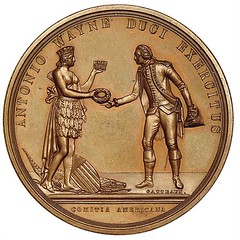

Len Augsburger writes:
As usual, John Adams is way ahead of us, for Washington's letter of transmittal was discussed in his Comitia Americana book in the chapter on the Wayne medal.
Kay O. Freeman writes:
A friend in New York went to Sotheby's today and saw the J.S. Copley items on advanced preview since sales of that collection do not start until April 2010. The George Washington / Anthony Wayne letter was on view with the Wayne medal, so Copley owned both. The lot is estimated $80,000-120,000.
John Adams writes:
Thank Heavens that the medal with the letter is from U.S. Mint copy dies. If it were an original, you could add another $100,000 or so to the estimate...
Kay adds:
General Wayne died in 1796, so he did not add the note. The 1817 notation might have been written by Isaac Wayne, Anthony Wayne's son. Online, there is a Wayne/Penrose bible with family vital dates. There one can see handwriting samples of various Wayne family members and compare with that of letter notation.
Who is the Dr. in Philadelphia who was doing a catalogue of medals?
Dave Bowers adds:
Mease was a pioneer figure in numismatics and is known to serious historians. Appended is a bit about him from my 2001 book, American Numismatics Before the Civil War.
At a time when ‘coin collectors' in the United States were popularly considered little better than monomaniacs, two or three gentlemen — Dr. J.B. Felt, of Salem, Mass., Mr. J. Francis Fisher, of Baltimore, and Dr. Jas. Mease, of Philadelphia — were deeply interested in the subject., and communicated the results of their investigations to societies of which they were members, or published them in a separate form.
In the 3d vol. of the New-York Historical Society's Collections (pp. 387-404), will be found a highly interesting paper by Dr. Mease, giving a description of 17 medals struck with reference to America; and this paper the Massachusetts Historical Society republished (Coll., vol. 4, 3d Series, 1834), together with additional particulars from the same hand concerning 33 medals presented to the officers of the war of 1812-14; and also of 4 other miscellaneous American medals.…
Although Felt would be recognized as the author of a pioneering book, the names of Messrs. Fisher and Mease were scarcely known to a later generation of numismatists.
Len Augsburger adds:
Regarding the Mease catalog, David Fanning recently offered a copy at in The Bookshelf, Vol. I, No. 3 (May 2009), lot 300. See www.fanningbooks.com/Bookshelf3Web.pdf .
What I find interesting about the letter of transmittal is that it mentions a copy of the Mease catalog as of 1817. So far as we know, the catalog initially published in 1821 as an article in "Collections of the New-York Historical Society." This indicates that Mease was at the task even four years earlier.
A landmark of early U.S. numismatic literature, Mease's article in this volume of the Collections of the Massachusetts Historical Society is a revision and expansion of his 1821 article published in the Collections of the New-York Historical Society, the first article written on a numismatic subject for numismatists.
While a number of American publications of numismatic interest predate Mease's 1821 article, these early publications were written for merchants, bankers, lawyers, politicians and other people who dealt with monetary issues on a daily basis. Works had not been written from the point of view of one who studies coins and medals. Indeed, no works written for numismatists were published in this country, to the best of my knowledge, between Mease's 1821 article and this 1834 revision.
In his groundbreaking lecture on the topic of U.S. numismatic literature, William S.F. Mayers writes, "the first actual attempts at systematic classification and record of the coins struck in or for the American colonies and United States, appear in the shape of papers to be found in the collections of State Historical Societies" ("The Literature of American Numismatics," Norton's Literary Letter, No. 3, 1859, p. 6). Mease's articles are specifically mentioned by Mayers in his article, showing that these works, long forgotten until recent years, were still in the memory of some in the late 1850s.
Though the 1821 version of the article is included in Attinelli's masterful 1876 Numisgraphics (p. 109), it is listed under "Historical Society of New York. Collections" with no mention of its contents or importance (and this revision isn't mentioned at all by him). Mease's 1821 article was reintroduced to modern scholars by Eric Newman in the Summer 1992 issue of The Asylum, the quarterly journal of the Numismatic Bibliomania Society, and has since been discussed by Joel Orosz in later issues of the same publication. The Newman article was also published in the August 1992 issue of The Numismatist.
James Mease, M.D. (1771–1846) was a polymath who published on an number of different subjects, including medicine, geology, and history. He was well known as the editor of the Domestic Encyclopedia (1803–04) and the Archives of Useful Knowledge (1811–12). His Picture of Philadelphia (1811) is a foundational work of local history and contains the first useful description of the U.S. Mint operations. Active in the American Philosophical Society and the Philadelphia Athenaeum, some of his papers are deposited in the William L. Clements Library at the University of Michigan. Mease would go on to publish the first numismatic examination of American coins in 1838.

Joel Orosz writes:
Mease led a fascinating life outside of numismatics. He stayed with Dr. Benjamin Rush in 1793 when most doctors fled the Philadelphia yellow fever epidemic (although the harsh methods they used probably killed many of their patients). He also was the father-in-law of one of the most celebrated actresses of the 19th century, Fanny Kemble. In between, he helped to settle a dispute in Philadelphia about the location of the home where Jefferson wrote the Declaration of Independence, by the simple method of writing Jefferson to ask him.
Eric Newman wrote an article about Dr. Mease in The Numismatist back in the 90s, and I wrote one for The Asylum about ten years ago.
To read the complete New York Times article, see: At Sotheby's, Tracing the Lives Behind the Letters (www.nytimes.com/2010/01/16/arts/design/16sothebys.html)
COIN WORLD'S 50TH ANNIVERSARY CELEBRATION PLANS
COIN World editor Beth Deisher writes:
I was surprised to read that you are wondering if we plan anything special for our 50th anniversary year. Perhaps you were busy over the holidays and did not have an opportunity to read my Editorial in our Jan. 4 issue, wherein I noted that as a part of our celebration this year we will be publishing five special editions that will explore by decade the events and people that have helped to shape and influence the hobby and marketplace as we know it today. Other aspects of our 50th anniversary celebration will be announced as we approach our actual anniversary on April 21.
COIN World founding Editor Dick Johnson adds:
Officially we called issue Volume 1, Number 0 the "Pilot Issue."
Gary Dunaier writes
To read the earlier E-Sylum article, see: COIN WORLD SAMPLE ISSUE: VOLUME 1, NUMBER 0 (www.coinbooks.org/esylum_v13n02a19.html)
THE BOOK BAZARRE
THE 1974 ASSAY COMMISSION AND THE ALUMINUM CENTS
 Comments in last week's The E-Sylum regarding 1974 aluminum cents brought back memories. I was on the 1974 Annual U.S. Assay Commission along with approximately 27 or 28 others including David Ganz and Maury Gould.
Comments in last week's The E-Sylum regarding 1974 aluminum cents brought back memories. I was on the 1974 Annual U.S. Assay Commission along with approximately 27 or 28 others including David Ganz and Maury Gould.
We were seated at a big table in alphabetical order. At some point the doors to the room were closed and locked and Mary Brooks, Director of the Mint, announced that there were 5 or 6 of the aluminum cents being passed around and nobody could leave the room until all had been returned.
When several of the 1974 cents got to us (Ganz, Gould, and Hallenbeck) we flipped them trying to match heads and tails for a brief bit of fun. Eventually all were returned and we were allowed to leave the room.
I was on the weighing committee. We were given sheets listing the weights of various coins, and the tolerances short or long permitted. I found one that was outside of the tolerance for that coin and called over one of the mint employees to point that out. Well, you'd have thought there was a bomb threat! This man later came back and explained that I had been given the wrong figures, and the new sheet had the correct figures.
With my somewhat warped sense of humor, I said "sure...", but with that tone of voice we all know which implies that I really didn't believe him. Well, this poor guy spent the next hour or two trying to convince me he was honestly correct with the new figures. Eventually, things went well.
It took me five or six years to get appointed to the Assay Commission, but was worth it. I've often wondered if the Assay Commission could be reinstated, that the government could actually charge to attend and make a profit. I certainly would be willing to pay to get on the commission again.
I used to say that next to getting married, the Assay Commission was my second most important event in my life, trumping the birth of our first child. This really annoyed my wife, so I had to switch my priorities to put my first child's birth second, and the Assay Commission third.
To read the earlier E-Sylum article, see: QUIZ ANSWER: THE 1974 ALUMINUM CENT (www.coinbooks.org/esylum_v13n02a07.html)
VOCABULARY ANSWER: A MEDAL WITH PORTRAIT BUT NO NAME
Regarding David Gracey's question, "What do you call a medal that features a portrait but does not include the name of the person portrayed?", Joe Boling writes:
In philately a cancellation that does not contain the locale where it was applied is called a mute cancel. It seems to me that that could apply to such medals as well.
Answer: No one word, but "unknown subject" is as close as you can get. You can find "portrait of unknown subject (or setter)" in catalog descriptions.
But please do not call the portrait "anonymous." This implies that the person portrayed chose not to be identified. In many instances the portrait appears after the subject is dead, so, obviously, could not chose to be unidentified.
I am going to break my rule not to publish any of my entries exactly from my Encyclopedia of Coin and Medal Technology before hand and reveal the exact wording of my definition and entry of anonymous. Here 'tis:
Anonymous. A numismatic or medallic item in which the creator – engraver, designer, sculptor, or minter – is unknown; an unsigned item. Anonymous is applied to items without initials, monogram or signature, precluding immediate identification of its maker. Sometimes anonymous items can be identified by documentary research, as by STYLISTIC COMPARISON with known items by the same artist (where the artist used the same mannerisms in several of his works). Often published or unpublished lists of an artist's work are the most productive sources for identifying anonymous works. See ART HISTORY.
A study of 19th century American tokens and medals revealed that 80 percent of these items were anonymous. We know the names of hundreds of early American engravers, but the custom – or practice – was for these engravers not to sign their dies.
Thus anonymous numismatic items are legion throughout history, both American and foreign. Many factors preclude an artist from signing his work: an embarrassment, by order of the issuer, or publisher, or government, or employer; or the fact the piece just does not justify a signature in the mind of the artist. An early anonymous medal is a Lucrezia Borgia Medal of 1502. See SIGNATURE.
The term "anonymous" is applied to artists only. If the portrait on a coin or medal is unknown it is termed: unknown subject and a catalog description might read "portrait of an unknown subject (or setter)."
References: CLASS 03.6 N2 {1958} Babelon, p 31.
There you have a free encyclopedia entry. To learn the other 1,835 entries you will have to purchase the book whenever it is published.
To read the earlier E-Sylum article, see: VOCABULARY QUERY: A MEDAL WITH PORTRAIT BUT NO NAME (www.coinbooks.org/esylum_v13n02a08.html)
MORE ON CIA MEDALS
Herb Friedman writes:
I enjoyed the comment about the CIA medals. At Langley, right outside the cafeteria there used to be a little store where you could buy caps, sweatshirts, and other items marked with the seal of the CIA. It is strictly for visitors. No agent is allowed to purchase or wear the items.

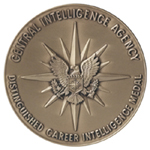
To read the earlier E-Sylum article, see: CENTRAL INTELLIGENCE AGENCY MEDALS (www.coinbooks.org/esylum_v13n02a16.html)
QUIZ ANSWER: WHAT ARE THESE COINS?
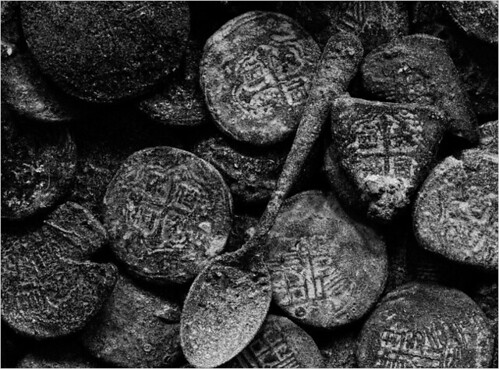
Pete Smith writes:
The last E-Sylum has a picture of some old Spanish coins. This image is part of a short film, "Figure 3", by Paul Sietsema on exhibition at the Museum of Modern Art.
Running on a whirring projector, the 16-minute black-and-white film "Figure 3" shows a series of still images of what appear to be old artifacts. There are partly broken ceramic bowls and vases; pottery shards; dirty, woven mattes; old, crusty coins; and so on. The film is grainy, dusty and seemingly old itself, so it looks like an archaeological documentary made early in the last century.
It turns out, however, that all the supposed artifacts represented were made by hand by Mr. Sietsema. So the film is an elaborate fake designed to prompt thought about how we imagine, preserve, authenticate and forget the past and how institutions of art, archaeology and history shape that process.
To read the complete article, see: Spirals of Self-Reflection, Made by Methods Mysterious (www.nytimes.com/2010/01/08/arts/design/08sietsema.html)
Pete Smith adds:
This reminds me of my visit to MOMA in 1984. I was amused by a painting that had one cent coins imbedded in the paint. This might make another E-Sylum quiz question.
To read the earlier E-Sylum article, see: QUICK QUIZ: WHAT ARE THESE COINS? (www.coinbooks.org/esylum_v13n02a09.html)
QUERY: MEDAL MAKERS NOBLE & BENTON
Has anyone heard of medal makers Noble & Benton? Perhaps they marked medals N&B.
There are newspaper reports that "Noble & Benton, Exchange Place", made three large silver medals that were presented December 1852. I do not think they were in New York City, but someplace in upstate New York. I am not sure if they worked in Rochester, NY, or Syracuse, NY, although Rochester city directories are online and I do not see them there. There are Exchange Places in both cities at that time.
The silver medals are reported "of very fine workmanship," "very handsomely finished up". Noble and Benton "whose skill have before attracted notice." The 1852 silver medals have a low-relief locomotive and tender and wreaths on one side. The other side has inscribed names of 28 presenters. Presenters and recipients were all associated with Rochester & Syracuse Railroad and/or Auburn and Syracuse Railroad.
I came across Noble & Benton whilst researching one of the medals' recipients. I have not seen the medals; I've only read about them and their manufacturers. I cannot find Noble & Benton candidates in the census - or anyplace. I've tried different spellings, and even thought of Toronto. Thanks for any help or thoughts.
THE BOOK BAZARRE
ARTICLE DOCUMENTS SOURCE OF A 1795 DOLLAR
For the record, the printed article has a couple of typos, both fixed here: the coin's date was incorrectly listed as "1796" and Dave's name incorrectly ordered as "David W. Perkins". Many thanks to Dave for permission to reprint excerpts from the article, and for providing the images and corrected text. -Editor

In this case someone bought the coin, in 1986. Likely all they knew of the story was from the catalog description. In this case the coin was Lot 1326 in Heritage Numismatic Auctions 1986 A.N.A. Mid-Winter Auction sale, February 20-22, 1986 held in Salt Lake City. This coin was plated in black and white on page 42 of the sale catalog, with an obverse photo in color included on page 41.
The catalog noted at the top of page 42:
These 25 early American dollars [Lots 1321-1345] constitute the major portion of the collection of a famous American Numismatist from Louisiana. Although HNAI was unable to use this gentleman's name, advanced Bolender collectors will decipher the owner's name due to the uniqueness of these properties. We trust that you will derive as much pleasure from viewing these as we did in cataloguing them; and for those of you fortunate to acquire one of these treasures, rest assured that you will have found a heritage of numismatists that undoubtably [sic] will be difficult to duplicate.
These silver dollars were from the collection of Frank M. Stirling of Baton Rouge, Louisiana. Frank Stirling died in Baton Rouge on September 18, 1984 at the age of 78. Stirling was a true and knowledgeable Numismatist. And as a side note, this was not the major portion of his collection; none-the-less this was an exceptional offering of 25 early silver dollars.
Now for the fun part. In April 2005 I acquired copies of Frank Stirling's correspondence and notes from the Stirling family. In looking through these files the other day I came across a number of letters between Stirling and B. Max Mehl, the famous Fort Worth coin dealer, a couple of which shed some additional light on this coin.

ROGER DEWARDT LANE'S REPORT ON THE 2010 FUN SHOW
Excellent issue of The E-Sylum. My, how young we looked 50 years ago, including Dick Johnson.
I took a Saturday bus trip to FUN with the Palm Beach Coin Club. I'm going to start out with a story I recall every time I think of FUN. It was my first show which was in Miami 1967 at the DuPont Plaza at Bayside. The hotel could not handle all the rooms needed for the meetings, so many were staying at the Everglades Hotel up a block or two on Biscayne Blvd.
The Everglades Hotel was known as the tallest hotel in Miami. There must have been some meeting there; my story starts with my being in an elevator almost full of FUN delegates. We all had those large Orange Badges on which said "FUN". There was only one tourist guest also in the elevator. So, as we rode up in the elevator, this tourist turned to the FUN people and said "What is FUN?" Several members said "It stands for Florida United Numismatists." The tourist responded "What church denomination is that?" Every one broke up with laughter.
Well, that was my first FUN Show and I was just starting to build my dime size silver type collection.
Back to the Bus trip. "Mutt & Jeff" left Hollywood at 5:45AM, picked up another member – Richard Anderson and headed for West Palm Beach, arriving just on time at 7:AM to be among the last of the 50 members to board the bus. The bus left on time for the three hour trip up the Florida Turnpike. It was cold outside, as when we got off, you could see your breath. The last time this happened to me, was 60 years ago in Maine!
The Show was very busy as it was Saturday with lots of local collectors walking the aisles.
I met for the first time Howard Daniel at the NI table. We had corresponded over the last forty years several times. He was quick to buy one of the two copies of my Encyclopedia Small Silver Coins, which I had with me (Show special price too). Howard gave me a copy of The Asylum 25 Years of the Numismatic Bibliomania Society, which was published before I joined NBS. Your article on the history of The E-Sylum was the first part I read last night, great story.
Everyone seemed pleased with the show. I added a few Mexican 10 Centavos for my collection and a .999. fine token of Mickey Mouse 1978 from Hollywood, Calif. Very expensive at $10, but I just had to have it, as it was about dime size.
Several other Florida Coin Clubs had bus parties their too. Our bus left on time at 5PM, arriving in West Palm Beach at 8: PM followed by the extra hour by car to get back home to Hollywood, just south of Ft. Lauderdale with three happy coin collectors.
WAYNE'S NUMISMATIC DIARY: JANUARY 12, 2010
Tuesday was the meeting on my Northern Virginia numismatic social group, Nummis Nova. We met at Bamian Afghan Restaurant in Falls Church, a great place picked out by Jon Radel. Already seated when I arrived were Jon, Chris Neuzil, and Dave Schenkman.
Shortly afterwards we were joined by Wayne Herndon and Traci Poole, who'd just returned from FUN show in Florida, where they'd enjoyed a dinner with Howard Daniel and Wayne's Wizard Coin Supply business sold about 4,000 pounds of numismatic books and supplies.
I told Wayne I heard that numismatic literature dealer John Burns had a good show, too. So good in fact, that John said I should write that he "had a grin so wide you could throw in a watermelon and not hit his teeth." Well, if you're a good shot, anyway.
The group's discussion veered into airline security and coin dealers carrying valuable (and heavy)! merchandise on board. Travelers can ask for a private inspection of their bags. Wayne noted that the level of examination can vary widely depending on the individual inspector. Some inspections are fairly cursory, while some inspectors "want you to take the coins out of their slabs" so they can get a closer look.
At a small airport like Long Beach, California, the inspectors get quite used to seeing a parade of coin dealers and their heavy briefcases of coins. Chris mentioned a similar phenomenon when he travelled home from the Tucson Gem & Mineral show, where inspectors practically waved through dealers bringing aboard boxes of rocks. I wondered if a "Yemeni carrying glowing rods" would be given a second look.
Other discussion topics covered a fairly wide range of numismatic and non-numismatic subjects. Dave Schenkman (former TAMS Journal editor) and I discussed Steve Bobbitt's appointment as the new editor. All of us were sad to learn this would be the last meeting for Traci Poole, who is moving back home to Idaho. She'll remain an E-Sylum subscriber at a new email address.
We had fun learning about the Idaho Potato Museum. It has a giant spud outside, and when it snows the snow looks like sour cream. Traci also informed us about the restaurant which offers "Free 'taters for out-of-staters", so when in Idaho, keep your non-Idaho drivers license handy for some free food.
At the end of the night we all gave Traci a hug and wished her well. Good luck! We'll miss you!
MAN WITH "IMPOSSIBLE" DISPLAY OF MEDALS ADMITS DECEPTION
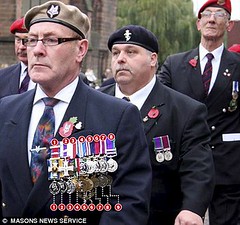 A bogus war hero who was exposed when he wore an "impossible" array of medals at a Remembrance Day parade has been sentenced to 60 hours' community service.
A bogus war hero who was exposed when he wore an "impossible" array of medals at a Remembrance Day parade has been sentenced to 60 hours' community service.
A court was told that 62-year-old Roger Day started lying about his military career to impress a younger woman he later married. Day told his wife, Maxine, that his original medals had been stolen and she set about putting together a replacement set, buying them from veterans and from the internet.
It was when Day wore the medals, which spanned the period from the Second World War to the Gulf War, at the parade in Bedworth, Warwickshire, that his deceit was unmasked.
Magistrates in Nuneaton heard that Day had met his bride-to-be at a local opera club and was desperate to impress her. She became his third wife in 2005, five years after they met.
Day, a father of three, admitted deception at Nuneaton Magistrates Court. The court heard that his only genuine military experience had been as a teenager in 1963 when attended an 18-month Junior Leaders course.
Mr Day married his wife, who is 24 years younger than him, five years ago. In order to maintain interest in him he made up stories about having served in the British Military and various accounts of bravery he was involved with.
"Out of kindness his wife began to purchase the medals from collectors as various replacements for him. He started wearing the medals over the years and began bragging and told stories to others while wearing the medals.
To read the complete article, see: Medal cheat Roger Day aimed to be a hero for his younger wife (www.timesonline.co.uk/tol/news/uk/crime/article6985115.ece)
To read the earlier E-Sylum article, see: ARTICLE EXAMINES MAN'S "IMPOSSIBLE" DISPLAY OF MEDALS (www.coinbooks.org/esylum_v12n50a20.html)
MAN ARRESTED AFTER LEAVING $500 TIP
Malaysian police have arrested a Lebanese man allegedly carrying fake currency with a face value of $66 million after he tipped a hotel staff with a $500 note, an official said Friday.
The largest U.S. note currently in wide circulation is a $100 bill. But police found bundles of $1 million, $100,000 and $500 notes in the man's hotel room in Kuala Lumpur on Sunday, said Izany Abdul Ghany, head of the city's commercial crime unit.
Hotel staff alerted police after a housekeeper received a $500 note tip and found out it was fake when she tried to convert it to local currency at a money changer, Izany said.
The man could be charged for possessing counterfeit money and, if found guilty, face up to 10 years in jail, he said.
To read the complete article, see: $500 tip leads police to $66 million in fake bills (news.yahoo.com/s/ap/as_odd_malaysia_generous_tip)
FEATURED WEB PAGE: WASHINGTON BEFORE BOSTON MEDAL
This week's Featured Web page is on the Washington Before Boston Medal, from the Coin and Currency Collections in the Department of Special Collections, University of Notre Dame Libraries.
On March 25, 1776, the Continental Congress authorized a medal to commemorate this event. Up through 1787 Congress authorized ten additional medals commemorating war heroes, however no medals were actually produced until 1790. In that year the federal Congress commissioned the Paris mint to produce these long overdue items. The Washington Before Boston medal was considered the most important and was the largest in the series, which is now referred to as the Comitia Americana (or American Congress) medal series. A gold example was presented to Washington along with a collection of eleven silver medals (nine of which were from the eleven medals authorized by congress); the gold example is now in the Boston Public Library while Washington's collection of eleven silver medals now resides in the Massachusetts Historical Society.
Since the first striking in 1790 the Paris mint has reissued these American Congress medals at various times in gold, silver, copper and bronze examples. The dating of examples can often be determined by the small symbol stamped on the edge of the medal: an antique lamp, 1832-1841; an anchor with the letter C, 1841-1842; a galley prow, 1842-1845; a pointing hand 1845-1860; a bee, 1860-1879 and a cornucopia 1880-present. In the 1860's hubs (i.e., punches for the images and legends) were made from the Paris dies and sent to Philadelphia were they were used to produce new dies for American struck examples.
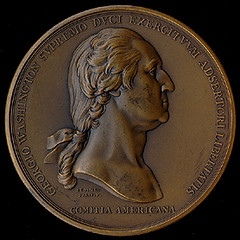
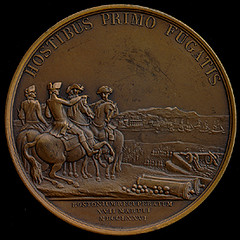
www.coins.nd.edu/WashToken/
WashTokenText/1790.html
